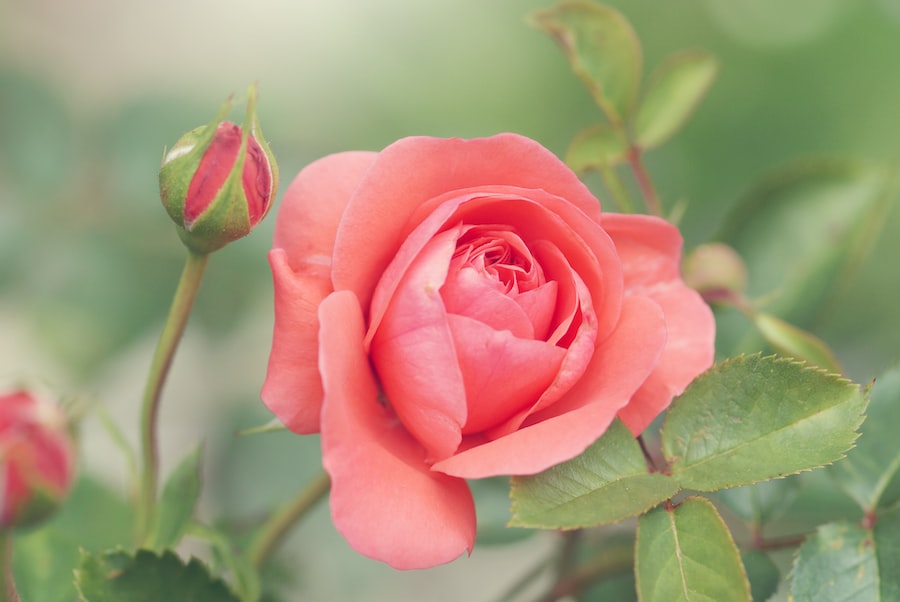Growing Your Garden: A Guide to Propagating Rose of Sharon

Rose of Sharon propagation is the process of creating new plants from existing ones. This can be done through various methods such as cuttings or seeds. Propagation is important because it allows gardeners to expand their collection of Rose of Sharon plants without having to purchase new ones. It also gives them the opportunity to share their plants with others, creating a sense of community and connection.
Key Takeaways
- Rose of Sharon propagation is a great way to expand your garden without spending a lot of money.
- Understanding the characteristics of the Rose of Sharon plant is important for successful propagation.
- Propagating Rose of Sharon can lead to a more diverse and beautiful garden.
- Preparing your garden and choosing the right propagation method are crucial steps in the process.
- Caring for newly propagated Rose of Sharon plants and troubleshooting common problems will ensure their success.
Understanding the Rose of Sharon Plant
The Rose of Sharon, also known as Hibiscus syriacus, is a deciduous shrub that belongs to the mallow family. It is native to Asia and has been cultivated for centuries for its beautiful flowers. The plant can grow up to 10 feet tall and has a spread of about 6 feet. It has dark green leaves that are ovate in shape and serrated edges.
The flowers of the Rose of Sharon are its most distinctive feature. They are large and showy, with five petals that come in a variety of colors including white, pink, purple, and blue. The flowers bloom from mid-summer to early fall and attract bees, butterflies, and hummingbirds.
There are many different varieties of Rose of Sharon available, each with its own unique characteristics. Some popular varieties include ‘Blue Bird’, which has blue flowers with a red center; ‘Diana’, which has white flowers; and ‘Aphrodite’, which has large pink flowers.
Benefits of Propagating Rose of Sharon
There are several benefits to propagating Rose of Sharon. One of the main benefits is cost savings. Instead of purchasing new plants, gardeners can propagate their existing ones for free. This can be especially beneficial for those who have a large garden or want to create a hedge or border using Rose of Sharon plants.
Another benefit is the ability to create more plants. By propagating Rose of Sharon, gardeners can increase their collection and have more plants to enjoy in their garden. They can also share their plants with friends and family, spreading the beauty of the Rose of Sharon to others.
Propagating Rose of Sharon also allows gardeners to preserve rare or heirloom varieties. Some varieties of Rose of Sharon may be difficult to find or no longer available in nurseries. By propagating these plants, gardeners can ensure their continued existence and pass them down to future generations.
Preparing Your Garden for Rose of Sharon Propagation
| Task | Timeframe | Tools Needed |
|---|---|---|
| Choose a healthy Rose of Sharon plant | Spring or Fall | Garden gloves, pruning shears |
| Prepare a rooting hormone solution | Before taking cuttings | Rooting hormone powder, water, container |
| Take cuttings from the Rose of Sharon plant | Spring or Fall | Pruning shears, rooting hormone solution |
| Prepare the planting area | Before planting cuttings | Garden trowel, compost, well-draining soil |
| Plant the Rose of Sharon cuttings | Spring or Fall | Garden trowel, water |
| Maintain the newly planted cuttings | Until established | Water, fertilizer, pruning shears |
Before propagating Rose of Sharon, it is important to prepare your garden. This includes preparing the soil and choosing the right location for the new plants.
Rose of Sharon prefers well-drained soil that is rich in organic matter. Before planting, amend the soil with compost or well-rotted manure to improve its fertility and drainage. This will provide a good foundation for the new plants to grow.
In terms of location, Rose of Sharon prefers full sun but can tolerate some shade. Choose a spot in your garden that receives at least 6 hours of direct sunlight per day. Avoid planting near large trees or structures that may shade the plants.
Choosing the Right Propagation Method for Rose of Sharon
There are several methods of propagating Rose of Sharon, including cuttings and seeds. Each method has its own pros and cons, so it is important to choose the one that best suits your needs and preferences.
Propagation from cuttings is a popular method because it allows gardeners to create exact replicas of the parent plant. This method is best done in late spring or early summer when the plant is actively growing. It involves taking a cutting from a healthy, mature plant and rooting it in a growing medium.
Propagation from seeds is another option, especially if you want to create a large number of plants. This method requires patience as it takes longer for the plants to reach maturity compared to cuttings. It also allows for genetic variation, so you may end up with plants that have different characteristics from the parent plant.
Propagating Rose of Sharon from Cuttings

To propagate Rose of Sharon from cuttings, follow these steps:
1. Select a healthy, mature stem from the parent plant. The stem should be about 6-8 inches long and have several nodes.
2. Using a sharp, clean pair of pruning shears, make a clean cut just below a node. Remove any leaves or flowers from the lower half of the cutting.
3. Dip the cut end of the cutting in rooting hormone to promote root development.
4. Fill a small pot with a well-draining potting mix. Make a hole in the center of the potting mix and insert the cutting.
5. Water the cutting thoroughly and place it in a warm, bright location. Keep the soil moist but not waterlogged.
6. After a few weeks, check for root development by gently tugging on the cutting. If there is resistance, it means roots have formed.
7. Once roots have formed, transplant the cutting into a larger pot or directly into the garden.
Propagating Rose of Sharon from Seeds
To propagate Rose of Sharon from seeds, follow these steps:
1. Collect seeds from mature seed pods in late fall or early winter. The seed pods should be brown and dry.
2. Soak the seeds in water for 24 hours to soften the seed coat and improve germination.
3. Fill a seed tray or small pots with a well-draining seed starting mix.
4. Sow the seeds on the surface of the soil and lightly press them down.
5. Cover the tray or pots with a clear plastic bag or plastic wrap to create a greenhouse effect.
6. Place the tray or pots in a warm location with indirect sunlight.
7. Keep the soil moist but not waterlogged. Mist the soil with water if it starts to dry out.
8. After a few weeks, the seeds should start to germinate. Once the seedlings have developed their first set of true leaves, transplant them into individual pots.
Caring for Newly Propagated Rose of Sharon Plants
After propagating Rose of Sharon, it is important to provide proper care for the newly propagated plants to ensure their success.
Water the plants regularly, especially during dry periods. Rose of Sharon prefers evenly moist soil but can tolerate some drought once established. Avoid overwatering as this can lead to root rot.
Fertilize the plants with a balanced fertilizer in early spring and again in mid-summer. Follow the instructions on the fertilizer package for application rates.
Prune the plants in late winter or early spring to remove any dead or damaged wood and to shape the plant. This will promote healthy growth and encourage more flowers.
Troubleshooting Common Rose of Sharon Propagation Problems
While propagating Rose of Sharon is generally a straightforward process, there are some common problems that can occur.
One problem is poor root development. This can be caused by using cuttings that are too young or too old, or by using a rooting medium that does not provide adequate drainage. To prevent this issue, make sure to use healthy, mature cuttings and a well-draining rooting medium.
Another problem is fungal diseases such as powdery mildew or root rot. These diseases can be prevented by providing good air circulation around the plants and avoiding overwatering. If you notice any signs of disease, treat the plants with a fungicide according to the instructions on the label.
Enjoying the Fruits of Your Rose of Sharon Propagation Efforts
Once your newly propagated Rose of Sharon plants have become established, you can enjoy their beauty in your garden. Prune the plants regularly to maintain their shape and promote more flowers. Remove any dead or damaged wood and thin out crowded branches.
In terms of maintenance, Rose of Sharon is a relatively low-maintenance plant. It does not require frequent watering once established and is generally resistant to pests and diseases. However, it is still important to monitor the plants for any signs of stress or disease and take appropriate action if necessary.
By propagating Rose of Sharon, you can not only expand your collection of plants but also share the beauty of this shrub with others. Whether you choose to propagate from cuttings or seeds, the process can be rewarding and enjoyable. With proper care and attention, your newly propagated Rose of Sharon plants will thrive and bring joy to your garden for years to come.
If you’re looking for more information on how to propagate Rose of Sharon, you might find this article from Lawn World helpful. They provide a comprehensive guide on propagating various plants, including Rose of Sharon. Check out their article on how to propagate Rose of Sharon for step-by-step instructions and expert tips. Additionally, you can explore their website’s sitemap for more gardening resources and articles. Happy propagating!



